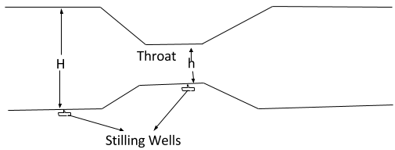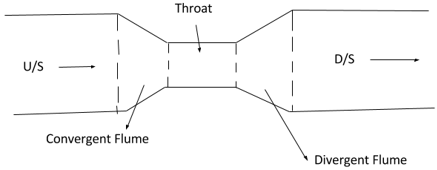This set of Irrigation Engineering Multiple Choice Questions & Answers (MCQs) focuses on “Regulation Modules – Metering Flumes Types”.
1. For what purpose is the meter used?
a) Measuring the amount of Silt entering the Canal
b) Measuring the Velocity of the Flow
c) Measuring the Hydraulic Jump
d) Measuring Discharge
View Answer
Explanation: The meter is a structure constructed in a canal for measuring the discharge of the canal accurately. It is an artificially flumed structure.
2. What is the slope of a throat?
a) From 0.5:1 to 1:1
b) From 1:1 to 3:1
c) From 1:1 to 2:1
d) From 1:3 to 1:2
View Answer
Explanation: By using the masonry walls the normal section of the channel is narrowed with a slope of 1:1 to 2:1 to a rectangular section known as the throat.
3. After the throat the channel is diverged to avoid the loss of head in the flume.
a) True
b) False
View Answer
Explanation: From the throat the channel is diverged so as to attain its normal section with the help of masonry wings with a slope of 2:1 to 10:1. Therefore due to gradual convergence and divergence the loss of head in the flume will be less.
4. Metering flumes works on the principle of venturi meter.
a) True
b) False
View Answer
Explanation: Since we use the throat for converging purpose in the flume the velocity of the flow increases. After the throat the channel is diverged for expansion, thus again the velocity becomes normal. Due to this increase and decrease of the velocity we can measure the discharge of the flow. This is quiet the procedure on which the venturi meter works. Hence, the metering flumes works on the principle of venturi meter.
5. How many types of metering flumes are used?
a) 3
b) 2
c) 4
d) 5
View Answer
Explanation: The two types of metering flumes used, which work on the principle of venturi meter are non-modular venturi flume and standing wave flume.
6. Which type of flume does the diagram depict?

a) Modular Venturi Flume
b) Free Flow Venturi Flume
c) Venturi Flume
d) Standing Wave Flume
View Answer
Explanation: The diagram represents a gradual channel leading to throat and gradual expanding of channel leading away. Moreover stilling wells are provided at the entrance and at the throat for measuring the head.
7. What is the formula for discharge when venturi meter is used?
a) \(Q = C_d (a_2/\sqrt{(a_1^2 – a_2^2)})\sqrt{2h}\)
b) \(Q = C_d (a_1 * a_2/\sqrt{(a_1^2 – a_2^2)})\sqrt{2gh}\)
c) \(Q = (a_1 * a_2/\sqrt{(a_1^2 – a_2^2)})\sqrt{2g}\)
d) \(Q = C_d (a_1/\sqrt{(a_1^2 – a_2^2)})\sqrt{2gh}\)
View Answer
Explanation: When the difference between the two stilling wells is h, then the discharge is given by the formula \(Q = C_d(a_1 * a_2 / \sqrt{(a_1^2 – a_2^2)})\sqrt{2gh}\) where, Cd = 0.95 to 1, a1 = area at entrance, and a2 = area at the throat.
8. What structure does the diagram represent?

a) Standing Wave Flume
b) Venturi Flume
c) Non modular Venturi Flume
d) Drowned Venturi Flume
View Answer
Explanation: The standing wave or say the hydraulic jump forms on the downstream glacis in the diverging channel. Therefore this diagram is standing wave flume.
9. What is the main drawback of standing wave flume?
a) Loss of Hydraulic Jump
b) Loss of Velocity of Flow
c) Loss of Head
d) Loss of Discharge
View Answer
Explanation: The main and only drawback of standing wave flume is that, it has a greater tendency for the loss of head (HL) and if this loss is not available it acts as a venturi meter. Due to this reason the canal fall sites are used as standing wave flumes.
10. What is the formula for discharge, when standing wave flume is used?
a) Q = 1.7 x B x H3/2
b) Q = 1.7 x Cd x B x H3/2
c) Q = 1.7 x Cd x B x H
d) Q = 1.7 x Cd x H3/2
View Answer
Explanation: When the width of the throat (B) is known we can calculate the discharge in the standing wave flume using the formula, Q = 1.7 x Cd x B x H3/2 where Cd = 0.95 to 1.
Sanfoundry Global Education & Learning Series – Irrigation Engineering.
To practice all areas of Irrigation Engineering, here is complete set of 1000+ Multiple Choice Questions and Answers.
If you find a mistake in question / option / answer, kindly take a screenshot and email to [email protected]
- Check Civil Engineering Books
- Check Irrigation Engineering Books
- Practice Agricultural Engineering MCQs
- Apply for Civil Engineering Internship
- Practice Civil Engineering MCQs
